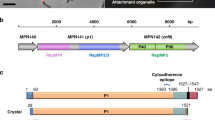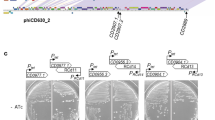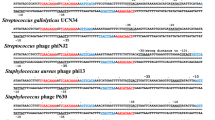Abstract
The immobilization antigens (i-antigens) of Paramecium, large polypeptides of relative molecular mass ∼300,000 (ref. 1), are located on the cell surface. Each i-antigen is encoded by a different unlinked gene, and no more than one gene is expressed at a time. The proteins and the mRNAs and genes encoding them are readily isolated2,3. Here we report the nucleotide sequence of three regions of the A i-antigen gene from stock 51 of Paramecium tetraurelia. Surprisingly, all reading frames contain TAA and TAG stop codons, even though there is evidence that one reading frame of these sequences codes for the i-antigen. We suggest that in Paramecium UAA and UAG code for amino acids, instead of serving as translational stops as they do in all other organisms.
This is a preview of subscription content, access via your institution
Access options
Subscribe to this journal
Receive 51 print issues and online access
$199.00 per year
only $3.90 per issue
Buy this article
- Purchase on Springer Link
- Instant access to full article PDF
Prices may be subject to local taxes which are calculated during checkout
Similar content being viewed by others
References
Sonneborn, T. M. in Handbook of Genetics Vol. 2 (ed. King, R. C.) 469–594 (Plenum, New York, 1975).
Preer, J. R., Preer, L. B. & Rudman, B. M. Proc. natn. Acad. Sci. U.S.A. 78, 6776–6778 (1981).
Forney, J. D. et al. Molec. cell. Biol. 3, 466–474 (1983).
Epstein, L. M. & Forney, J. D. Molec. cell. Biol. 4, 1583–1590 (1984).
Steers, E. Jr Biochemistry 4, 1896–1901 (1965).
Reisner, A. H. & Rowe, J. Nature 222, 558–559 (1969).
Shepherd, J. C. W. Proc. natn. Acad. Sci. U.S.A. 80, 1194–1198 (1981).
Caron, F. & Meyer, E. Nature 314, 185–188 (1985).
Helftenbein, E. Nucleic Adds Res. (submitted).
Horowitz, S. & Gorovsky, M. Proc. natn. Acad. Sci. U.S.A. (submitted).
Hruby, D. E., Maki, R. A. & Cummings, D. J. Biochim. biophys. Acta 477, 89–96 (1977).
David, E. T. & Smith, K. E. Biochem. J. 194, 761–770 (1981).
Rinaldy, A. R., Wethoff, P., Janker, F., Seyfert, H. M. & Cleffmann, G. Expl Cell Res. 134, 417–423 (1981).
Meyer, E., Caron, F. & Guiard, B. Biochimie 66, 403–412 (1984).
Maxam, A. M. & Gilbert, W. Proc. natn. Acad. Sci. U.S.A. 74, 560–564 (1977).
Author information
Authors and Affiliations
Rights and permissions
About this article
Cite this article
Preer, J., Preer, L., Rudman, B. et al. Deviation from the universal code shown by the gene for surface protein 51A in Paramecium. Nature 314, 188–190 (1985). https://doi.org/10.1038/314188a0
Received:
Accepted:
Issue Date:
DOI: https://doi.org/10.1038/314188a0
This article is cited by
-
Widespread stop-codon recoding in bacteriophages may regulate translation of lytic genes
Nature Microbiology (2022)
-
Programmed genome rearrangements in ciliates
Cellular and Molecular Life Sciences (2020)
-
Nuclear genetic codes with a different meaning of the UAG and the UAA codon
BMC Biology (2017)
-
Augmented genetic decoding: global, local and temporal alterations of decoding processes and codon meaning
Nature Reviews Genetics (2015)
-
What history tells us IV. Ciliates as models… of what?
Journal of Biosciences (2006)
Comments
By submitting a comment you agree to abide by our Terms and Community Guidelines. If you find something abusive or that does not comply with our terms or guidelines please flag it as inappropriate.



